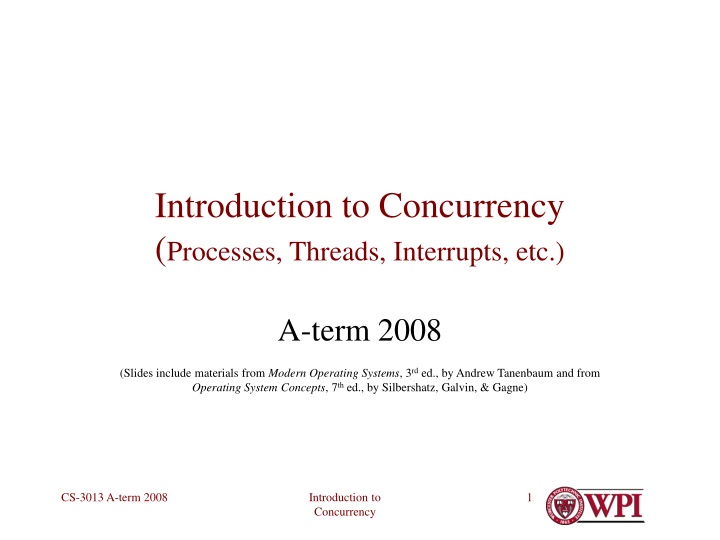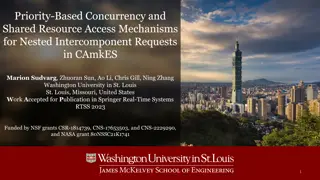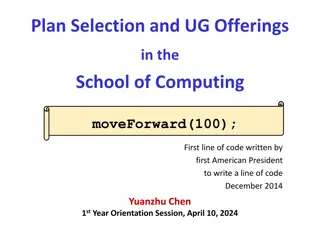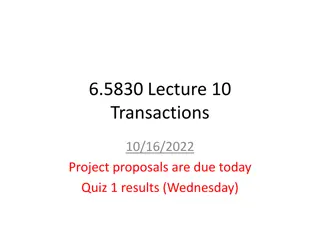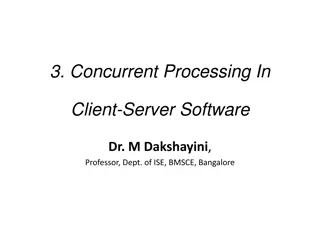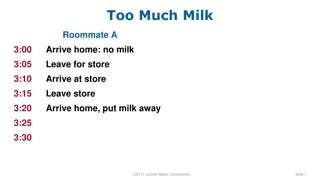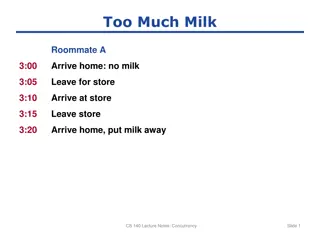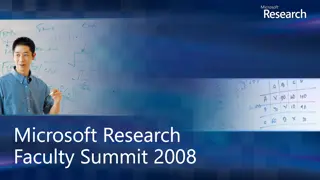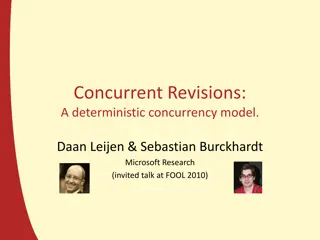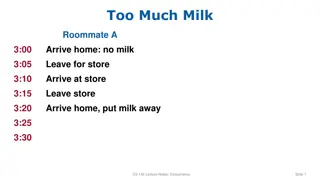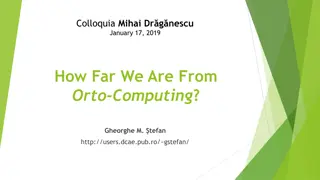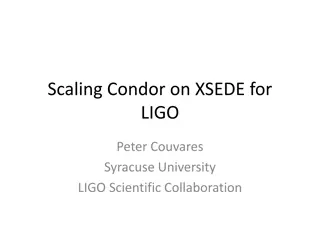Introduction to Concurrency in Computing
Concurrency in computing involves managing multiple activities simultaneously, from early challenges with I/O synchronization to modern applications like workstations, PCs, and game implementations. Learn about the evolution and significance of concurrency in this informative presentation.
Download Presentation

Please find below an Image/Link to download the presentation.
The content on the website is provided AS IS for your information and personal use only. It may not be sold, licensed, or shared on other websites without obtaining consent from the author.If you encounter any issues during the download, it is possible that the publisher has removed the file from their server.
You are allowed to download the files provided on this website for personal or commercial use, subject to the condition that they are used lawfully. All files are the property of their respective owners.
The content on the website is provided AS IS for your information and personal use only. It may not be sold, licensed, or shared on other websites without obtaining consent from the author.
E N D
Presentation Transcript
Introduction to Concurrency (Processes, Threads, Interrupts, etc.) A-term 2008 (Slides include materials from Modern Operating Systems, 3rd ed., by Andrew Tanenbaum and from Operating System Concepts, 7th ed., by Silbershatz, Galvin, & Gagne) CS-3013 A-term 2008 Introduction to Concurrency 1
Concurrency I.e., things happening at the same time Since the beginning of computing, management of concurrent activity has been the central issue Concurrency between computation and input or output Concurrency between computation and user Concurrency between essentially independent activities that take place at same time Concurrency between parts of large computations that are divided up to improve performance CS-3013 A-term 2008 Introduction to Concurrency 2
Early 1960s Programmers tried to write programs that would read from input devices and write to output devices in parallel with computing Card readers, paper tape, line printers, etc. Challenges Keeping the buffers organized Synchronizing between I/O activity and computation Computation getting ahead of I/O activity I/O activity getting ahead of computation CS-3013 A-term 2008 Introduction to Concurrency 3
Mid-late 1960s Shared Computing Services Multiple simultaneous, independent users of large computing facilities E.g., Time Sharing systems of university computing centers Data centers of large enterprises Multiple accounting, administrative, and data processing activities over common databases CS-3013 A-term 2008 Introduction to Concurrency 4
Modern Workstations and PCs Multiple windows in personal computer doing completely independent things Word, Excel, Photoshop, E-mail, music, etc. Multiple activities within one application E.g., in Microsoft Word Reading and interpreting keystrokes Formatting line and page breaks Displaying what you typed Spell checking Hyphenation . CS-3013 A-term 2008 Introduction to Concurrency 5
Modern Game Implementations Multiple characters in game Concurrently & independently active Multiple constraints, challenges, and interactions among characters Multiple players CS-3013 A-term 2008 Introduction to Concurrency 6
Technological Pressure From early 1950s to early 2000s, single processor computers increased in speed by 2 every 18 months or so Moore s Law Multiprocessing was somewhat of a niche problem I.e., computing systems with more than one CPU Specialized computing centers, techniques CS-3013 A-term 2008 Introduction to Concurrency 7
Technological Pressure (continued) No longer! Modern microprocessor clock speeds are no longer increasing with Moore s Law Microprocessor density on chips still is! multi-threaded and multi-core processors are now de facto standard Even on low-end PCs! CS-3013 A-term 2008 Introduction to Concurrency 8
Traditional Challenge for OS Useful set of abstractions that help to Manage concurrency Manage synchronization among concurrent activities Communicate information in useful way among concurrent activities Do it all efficiently CS-3013 A-term 2008 Introduction to Concurrency 9
Modern Challenge Methods and abstractions to help software engineers and application designers Take advantage of inherent concurrency in modern application systems Exploit multi-processor and multi-core architectures that are becoming ubiquitous Do so with relative ease CS-3013 A-term 2008 Introduction to Concurrency 10
Fundamental Abstraction Process aka Task aka Thread aka Job aka [other terms] CS-3013 A-term 2008 Introduction to Concurrency 11
Definition Process (generic): A particular execution of a particular program. Requires time, space, and (perhaps) other resources Separate from all other executions of the same program Even those at the same time! Separate from executions of other programs CS-3013 A-term 2008 Introduction to Concurrency 12
Process(continued) Can be Interrupted Suspended Blocked Unblocked Started or continued Fundamental abstraction of all modern operating systems Note: Process in Unix, Linux, and Windows is a heavyweight concept with more implications than this simple definition CS-3013 A-term 2008 Introduction to Concurrency 13
Process(a generic term continued) Concept emerged and evolved in 1960s Intended to make sense out of mish-mash of difficult concurrent programming techniques that bedeviled software engineers Analogous to police or taxi dispatcher! CS-3013 A-term 2008 Introduction to Concurrency 14
Background Interrupts A mechanism in (nearly) all computers by which a running program can be suspended in order to cause processor to do something else Two kinds: Traps synchronous, caused by running program Deliberate: e.g., system call Error: divide by zero Interrupts asynchronous, spawned by some other concurrent activity or device. Essential to the usefulness of computing systems CS-3013 A-term 2008 Introduction to Concurrency 15
Hardware Interrupt Mechanism Upon receipt of electronic signal, the processor Saves current PSW to a fixed location Loads new PSW from another fixed location PSW Program Status Word Program counter Condition code bits (comparison results) Interrupt enable/disable bits Other control and mode information E.g., privilege level, access to special instructions, etc. Occurs between machine instructions An abstraction in modern processors (see Tanenbaum, 5.1.5) CS-3013 A-term 2008 Introduction to Concurrency 16
Interrupt Handler /* Enter with interrupts disabled */ Save registers of interrupted computation Load registers needed by handler Examine cause of interrupt Take appropriate action (brief) Reload registers of interrupted computation Reload interrupted PSW and re-enable interrupts or Load registers of another computation Load its PSW and re-enable interrupts CS-3013 A-term 2008 Introduction to Concurrency 17
Requirements of interrupt handlers Fast Avoid possibilities of interminable waits Must not count on correctness of interrupted computation Must not get confused by multiple interrupts in close succession More challenging on multiprocessor systems CS-3013 A-term 2008 Introduction to Concurrency 18
Result Interrupts make it possible to support concurrent activities Don t help in establishing some kind of orderly way of thinking Need something more CS-3013 A-term 2008 Introduction to Concurrency 19
Hence, emergence of generic concept of process (or whatever it is called in a particular operating system and environment) Notion of process allows us to abstract interrupts and interleaving and concentrate on each executing program separately CS-3013 A-term 2008 Introduction to Concurrency 20
Information the system needs to implement a process PSW (program status word) Program counter Condition codes Control information e.g., privilege level, priority, etc Registers, stack pointer, etc. Whatever hardware resources needed to compute Administrative information for OS Owner, restrictions, resources, etc. Other stuff CS-3013 A-term 2008 Introduction to Concurrency 21
Process Control Block (PCB) (example data structure in an OS) CS-3013 A-term 2008 Introduction to Concurrency 22
Switching from process to process CS-3013 A-term 2008 Introduction to Concurrency 23
Result A very clean way of thinking about separate computations Processes can appear be executing in parallel Even on a single processor machine Processes really can execute in parallel Multi-processor, multi-core, or multi-threaded hardware CS-3013 A-term 2008 Introduction to Concurrency 24
Process States CS-3013 A-term 2008 Introduction to Concurrency 25
The Fundamental Abstraction of the OS Each process has its virtual processor Each process can be thought of as an independent computation On a fast enough physical processor, processes can look like they are really running concurrently CS-3013 A-term 2008 Introduction to Concurrency 26
Questions? CS-3013 A-term 2008 Introduction to Concurrency 27
Implementation of Processes Ready queue PCB PCB PCB PCB or Ready queue1 Ready queue1 PCB PCB PCB PCB PCB PCB PCB PCB Ready queue2 PCB PCB PCB PCB Ready queuen PCB PCB PCB PCB CS-3013 A-term 2008 Introduction to Concurrency 28
Implementation Ready queue PCB PCB PCB PCB Action dispatch a process to CPU Remove first PCB from ready queue Load registers and PSW Return from interrupt or trap Action interrupt a process Save PSW and registers in PCB If not blocked, insert PCB back into ReadyQueue (in some order); otherwise, link it to some other queue or list Take appropriate action Dispatch same or another process from ReadyQueue CS-3013 A-term 2008 Introduction to Concurrency 29
Timer interrupts Can be used to enforce fair sharing Current process goes back to ReadyQueue After other processes of equal or higher priority Simulates concurrent execution of multiple processes on same processor CS-3013 A-term 2008 Introduction to Concurrency 30
Processes Switching When a process is running, its hardware state is in the processor PC, processor registers, etc. When the OS suspends running a process, it saves the hardware state in the PCB When the OS dispatches a process, it restores the hardware state from the PCB CS-3013 A-term 2008 Introduction to Concurrency 31
Definition Context Switch The act of switching from one process to another E.g., upon interrupt or some kind of wait for event Not a big deal in simple systems and processors Very big deal in large systems such Linux and Windows Pentium 4, etc. Many microseconds! CS-3013 A-term 2008 Introduction to Concurrency 32
Definition Scheduling The art and science of deciding which process to dispatch next and for how long and on which processor Topic for later in this course CS-3013 A-term 2008 Introduction to Concurrency 33
Questions? Next Topic CS-3013 A-term 2008 Introduction to Concurrency 34
